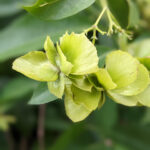Botanical Name/Etymology: Sesamum indicum (syn. S. orientale)
Family Name: Pedaliaceae
Common Name(s) — sesame, benne (African), gingili, semsent (ancient Egyptian), til, ajonnoli, tahini (ground paste), halvah. The botanical and common names of Sesamum and sesame are believed to be derived from the Arabic work for the plant and seeds: simsim.
Origin – Native to Africa, but has been grown in India and the Near East for thousands of years and thus the specific epithet which would lead us to believe it is native to India.
History – Sesame seed is considered to be the oldest oil seed crop cultivated by mankind (though some argue that linseed was produced earlier). It is mentioned as semsent in the Egyptian Ebers papyri (a 65-feet-long scroll listing ancient herbs and spices discovered by the famous German Egyptologist, Ebers – dating to c. 1500 BC) and was grown in both Egypt and Babylonia between 2200 and 538 BC. An excavated site near Yerevan, Armenia, produced jars of sesame seeds that are from c. 900-600 BC, as well as elaborate equipment for the extraction of oil. It is one of the plants that was found in the tomb of the pharaoh Tutankhamen (1370-1352 BC).
Growth Habit – Upright annual from 2-6 feet in height. It loves heat and is drought tolerant. Leaves: broadly lanceolate, opposite, and with an entire margin. They are around 2 inches wide and up to 5 inches long, but noticeably smaller as they progress up the plant to the flowering tips. The foliage has a notable pungent aroma. Flowers: white, about 1 inch long, and tubular – perfectly sized to fit bees, which are their pollinator. The flowers may also be yellow, purple, or blue depending upon variety. Fruit: the seed pod is a capsule which has four grooves and contains many seeds.
Growth (Cultural) Requirements — Well-drained, sandy soil in full sun with warm temperatures. Seed should be sown when the soil temperature is above 65°F. Requires approximately 100 days to mature.
Propagation – directly sown seed.
Folklore – In Scheherazade’s telling of Ali Baba and the Forty Thieves in One Thousand and One Arabian Nights, the term “open sesame” is used to open up the sealed cave where a group of thieves resides. It is believed that this term is a reference to the fact that a dry sesame seed pod will burst open at the slightest touch.
Chemistry – Seeds are rich in protein, unsaturated oil, vitamins B3, E, folic acid, and minerals, especially calcium (which is notably in a form that is easily absorbed by the body). The seeds are approximately 55% oil, comprising mainly oleic and linoleic acids, and 26% protein. (Chevalier)
Plant Part(s) Used — Seeds (mainly), leaves and roots (medicinal).
Time of Harvest – Seeds are collected when ripe (seed pods turn brown) and stored whole, pressed for oil, or ground into paste (tahini).
Culinary Uses – The seeds are most commonly toasted before use to enhance flavor. They are commonly used whole in breads, savory dishes, cakes, cookies, and a variety of confections – even molded with a sugary bonding to make a variety of shapes. The seeds are also commonly ground to make a paste called tahini, which is a base flavoring for hummus. Tahini is also used in combination with whole sesame or other nuts and honey to make a sweetmeat known as halvah. The seed oil is used for cooking and adding flavor to dishes such as stir-fries. It is very popular in Japan and is noted for its long shelf life: it is slow to become rancid. This is likely due to its high content of two antioxidants – sasamolin and sesamium. (Simpson and Ogorzaly) The black sesame seeds have a more potent taste and are commonly utilized in the cuisines of Southeast Asia.
Other Uses – The oil is used in both soaps and emollients. It was also historically used as a lamp oil, especially in Egypt and the Near East.
Henry Flowers, HSA Pioneer Unit Botany Study Group
(It is the policy of The Herb Society of America not to advise or recommend herbs for medicinal or health use. This information is intended for educational purposes only and should not be considered as a recommendation or an endorsement of any particular medical or health treatment.)










